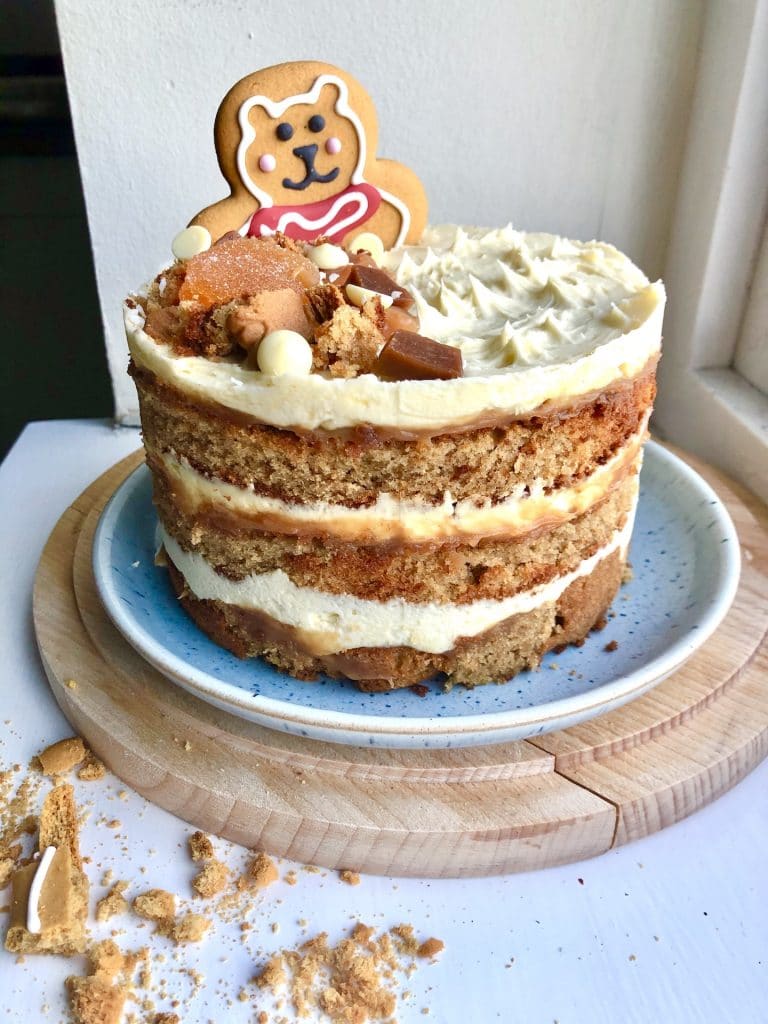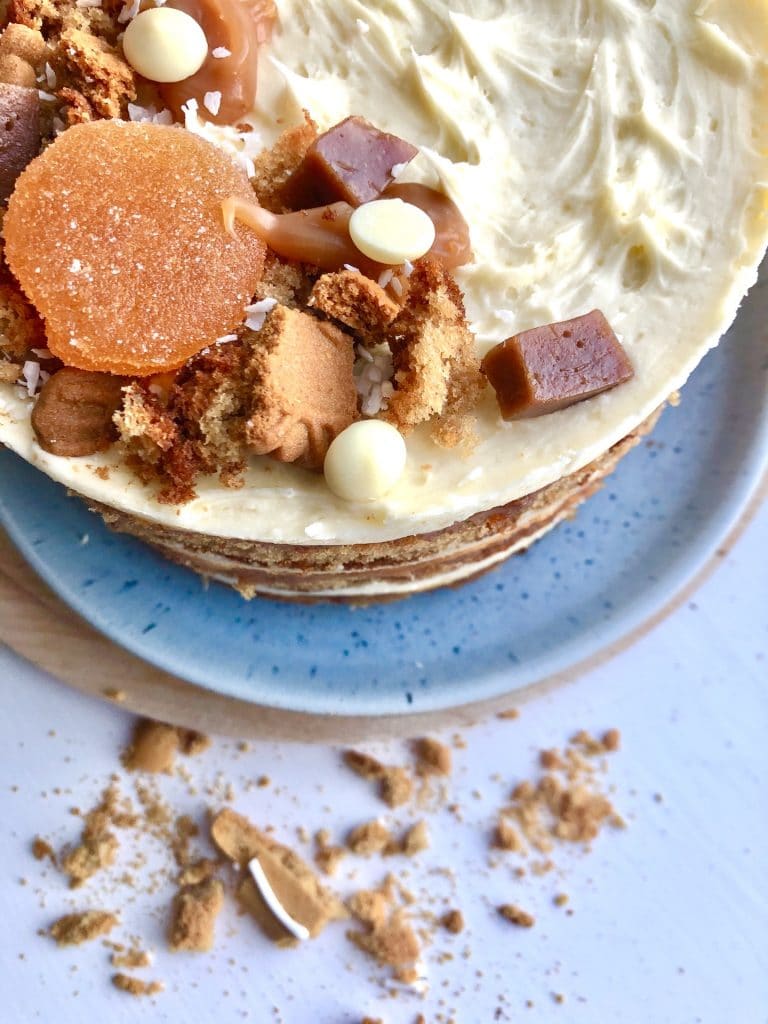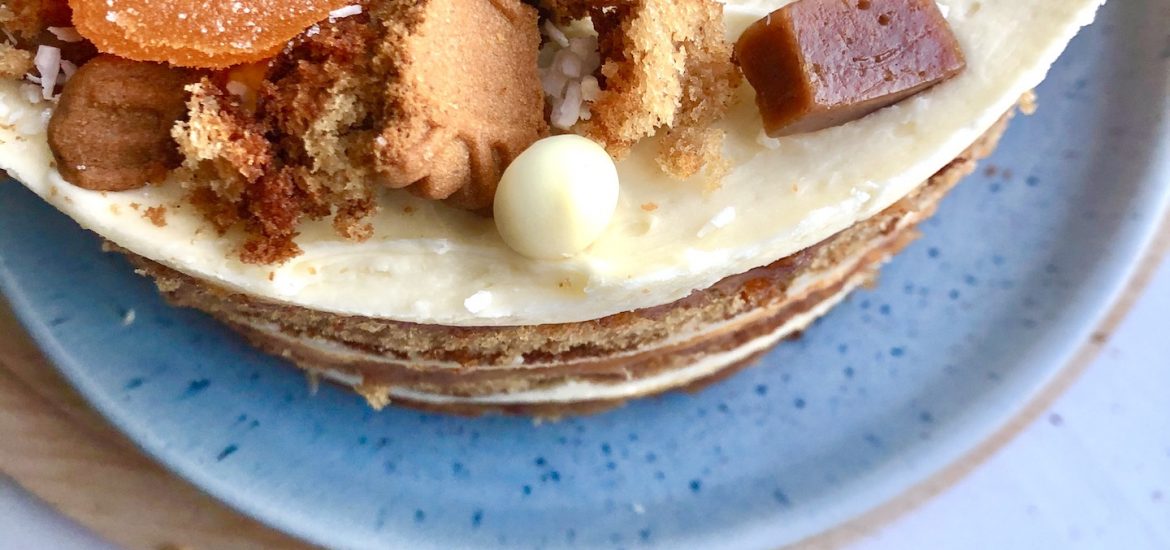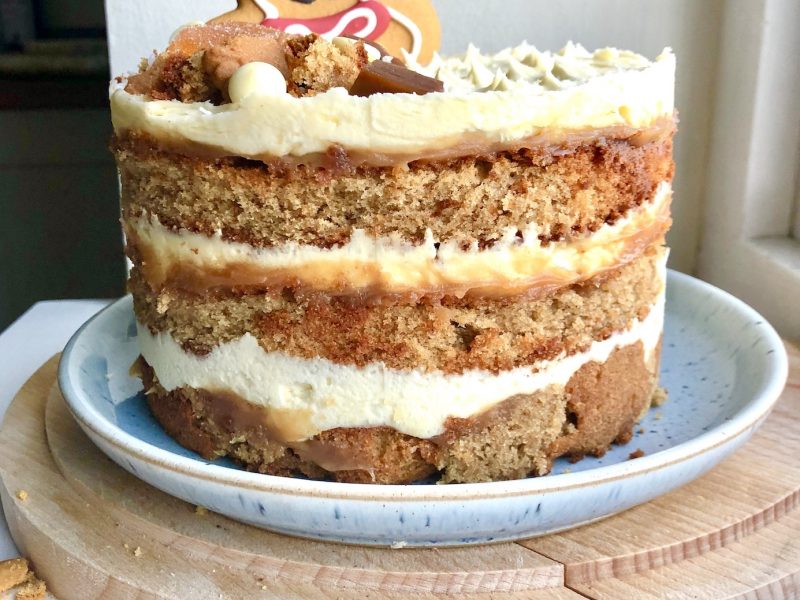Gingerbread Layer Cake with salted caramel; fluffy spiced ginger cake layered with salted caramel, fluffy vanilla frosting and biscuit crumbs.
this post contains affiliate content
This post is brought to you by my deep desire to live inside a giant gingerbread house. While the lack of structural integrity and proneness to damp may be mildly off-putting, you can’t deny it would be joyful.
That gingerbread smell is just so intoxicating. Hot spicy ginger, cosy cinnamon, dark brown sugar. It is the idyllic scent of the festive season, and one you can find all across European bakeries in the run up to Christmas. (Once you’ve finished seeking out Gregg’s festive bakes, of course.)

Delicious as these fiery crunchy biscuits are, there’s always something undeniably fiddly about making them. Piping little happy faces on the hundreds of biscuits spread across your worktop, or carefully engineering a biscuit roof onto wobbly walls. Of course, you can go out and buy them, but that would mean skidding on frosty pavements and a cold runny nose. No thanks.

While I’ve made a few gingerbread structures in my life, I take much more joy in devouring the biscuits and savouring their flavour than I do in complicated construction. Hence the lazy inspiration for today’s Gingerbread Layer Cake with salted caramel.
This Gingerbread Layer Cake brings all of the warm spices of the season with none of the delicate faffing. Once you’ve layered this beauty up, you can enjoy 8-12 servings of cosy Christmas flavour without fear of wrecking the best edible ornament in the house.
Cinnamon, ginger, and nutmeg laced cake layers sweetened with brown sugar. A splash of warming brandy. A lick of deep salty caramel. A snowy vanilla frosting, whipped into cloud-like fluff between the layers.
Prefer something more chocolatey at Christmas? Click here!

The fun doesn’t have to stop at the layering. I chucked enough decorations on this cake to bring not only the look, but the flavour of a gingerbread house. The ginger flavour from the cake and the layers of salted caramel mimic the components of a gingerbread house and its glue. The true joy is adding gingerbread people, colourful sweets, chocolates, snowy bits and more.
Of course, you can add whatever you like inside the cake too. I imagine a handful of toasted pecans would add nothing but pleasure to this Gingerbread Layer Cake. An extra glug of brandy in the buttercream frosting too? Yes please, ma’am.
The cake you see pictured has been layered up using a cake ring and a sheet of acetate. However, while I enjoy this style of entremet layering, you can just as easily bake this cake into two round 6-inch cake tins and layer it up how you like.

This Gingerbread Layer Cake with salted caramel is an absolute dream throughout the holiday season. It could be a great Christmas day dessert, a nice Boxing Day treat to use up remaining ingredients, or something just to whip up on a chilly Sunday. As you know, I don’t believe in the need for excuses to make or eat delicious desserts.
I hope you guys adore this cake as much as we do. Stay happy, stay safe and thanks as always for stopping by!
To save this Gingerbread Layer Cake with salted caramel for later, simply pin the image below:

To make this Gingerbread Layer Cake, simply follow the recipe below:
Gingerbread Layer Cake with salted caramel
Notes
BE A MAVERICK: Why not add a splash of booze to the frosting before mixing for an extra rich festive flavour? Brandy, cognac or Baileys would be delicious!
This Gingerbread Layer Cake with salted caramel should keep well for up to 3 days in an airtight container or covered cake stand. No need to refrigerate unless you live somewhere very warm, or you like cold cake!
If not assembling using a cake ring and acetate like I did, simply bake the cake in two round 15cm (6 inch) cake tins. You can then layer it up and decorate with the caramel, frosting and crumbs as you please!
Ingredients
For the salted caramel:
- 200g (1 cup) caster sugar
- 100ml (scant ½ cup) cold water
- 100g (7 tbsp) soft unsalted butter
- 100ml (scant ½ cup) double or whipping cream
- 1 tsp flaky sea salt
For the gingerbread cake:
- 200g (13 tbsp) soft salted butter or margarine
- 200g (1 cup) soft brown sugar
- 1 tsp vanilla extract
- 3 large eggs
- 200g (1 ¾ cups) self-raising flour
- 1 tbsp ground ginger
- 1 tsp ground cinnamon
- 1 tsp ground mixed spice
- ¼ tsp ground nutmeg
For the vanilla frosting:
- 200g (13 tbsp) salted butter
- 350g (2 ¾ cups) icing sugar
- 2 tsp vanilla extract
- 1 tbsp lemon juice
To assemble:
- Gingerbread or Biscoff biscuits, broken into chunky crumbs
- Glug of brandy, cognac, or your favourite liqueur (optional)
- Gingerbread biscuits, sweets, chocolate chips, and other treats, to decorate
Instructions
For the salted caramel:
- Pour your sugar and water into a small saucepan and set it over a medium-high heat.
- Allow to bubble and boil until the sugar has dissolved and the mixture has turned a deep amber colour. This can take up to 10 minutes. (You can swirl or shake the pan but don’t stir as the caramel may crystallise!)
- Remove the pan from the heat and whisk in the butter until melted. Be very careful as the mixture may splatter slightly.
- Whisk through the double cream and salt until smooth.
- Pour the salted caramel into a heatproof bowl, jug or jar.
- Set aside and allow to cool while you prepare the other cake components.
For the gingerbread cake:
- Preheat your oven – 180 C / 160 C fan / 350 F / gas mark 4.
- Grease and line a 25cm x 31cm (10in x 12in) baking tray or roasting tin. If not assembling using a cake ring and acetate like I did, simply bake the cake in two round 15cm (6in) cake tins.
- In a large bowl, beat together the butter/margarine, vanilla and the sugar until fluffy. This should take 2-3 minutes.
- Add the eggs one at a time, beating well between each.
- Gently stir in the flour until just combined into a smooth cake batter.
- Pour the cake batter into your prepared tray and smooth it out.
- Bake for 20-30 minutes until risen, golden and firm to the touch. A skewer inserted into the centre of the cake should be removed cleanly once it is baked.
- Remove from the oven and allow to cool.
- Meanwhile, make your frosting.
For the vanilla frosting:
- In a large bowl, beat all your frosting ingredients together vigorously for a few minutes until pale and fluffy. This is easiest with an electric mixer or whisk!
To assemble:
- Once the caramel and cake are cool, and you have made the frosting, it’s time to assemble!
- (If not assembling using a cake ring and acetate: simply spread the caramel and frosting between the two cooled layers of cake with a scattering of biscuits crumbs, and repeat the same on top!)
- Use your cake ring (adjusted to 15cm) to cut out two circles of cake. Gather up the scraps as this will form the bottom layer of your cake.
- Clean and dry the cake ring and place it either on a board or the plate you want to serve it on.
- Line the ring with a strip of 7.5cm x 50cm acetate.
- Put the cake scraps inside the ring and use your hand to press them down into a flat even layer. Any leftover scraps are perfect for snacking on while you finish assembling!
- Spoon or brush a splash of brandy/liqueur over the flat cake layer (if using).
- Spread some of your caramel on top
- Spread one-third of your frosting on top of the caramel layer.
- Scatter over a handful of your biscuit crumbs, pressing them down gently into the frosting.
- Repeat the entire assembly process again for the second and third layer. You should have used up all of your frosting, but will likely have caramel leftover.
- Place the cake in the fridge to chill for 1-2 hours until the frosting and caramel are firm.
- Gently remove the cake ring, peel off the acetate, and decorate using anything you like. I used gingerbread biscuits, chocolate chips, homemade jelly sweets and caramels.
- Enjoy!




